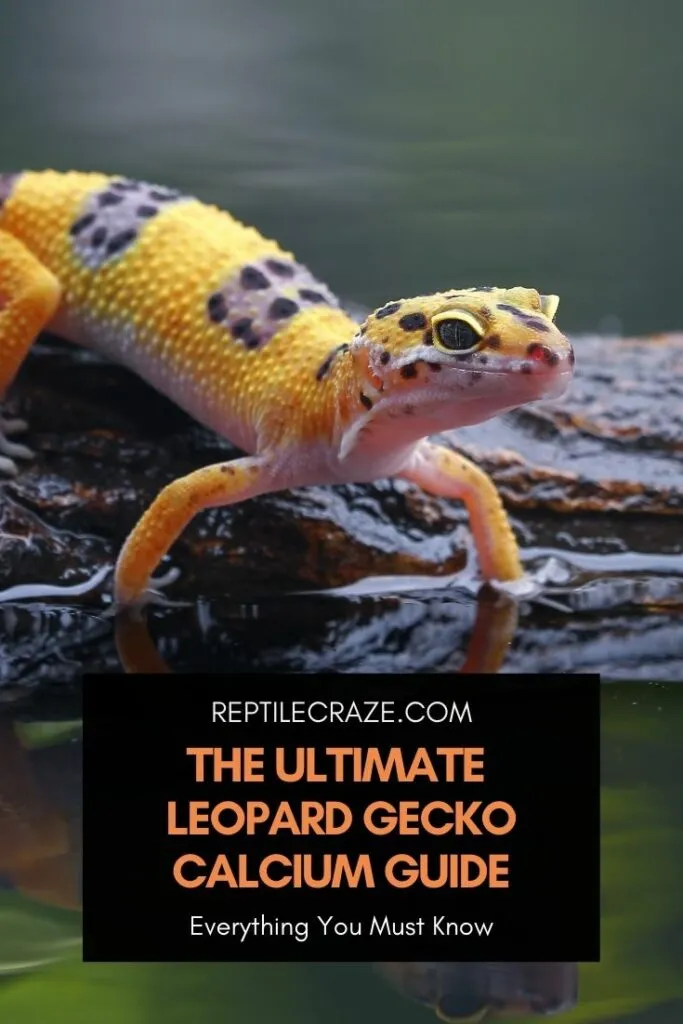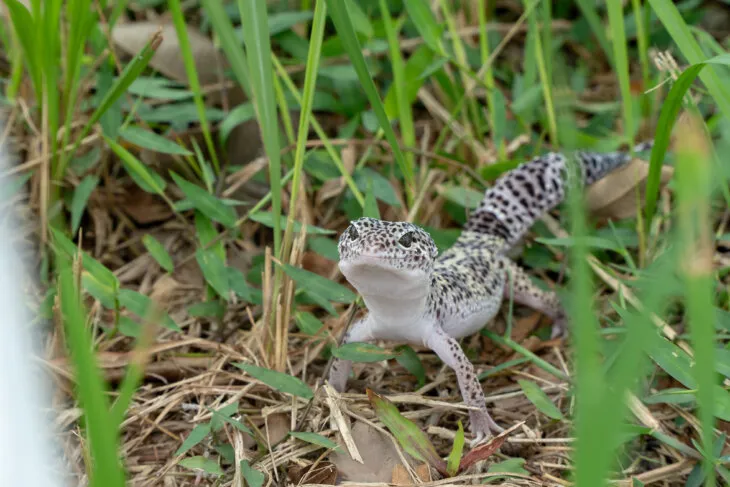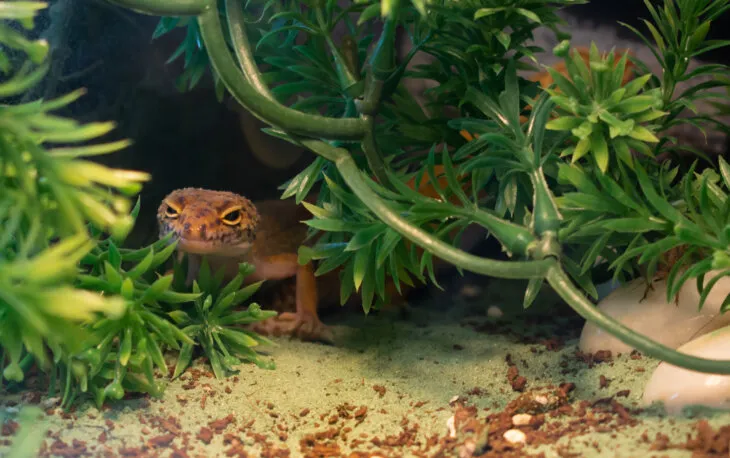
Science tells us that calcium is one of the most indispensable minerals for leopard geckos. In the wild, leos feed on a variety of
Leopard geckos that live in captivity require calcium supplementation since the bulk of their common feed (feeder insects) is a poor calcium source. Their growth is also faster in captivity, increasing the demand for supplementary calcium to support bone development.
This article will provide you with comprehensive information about calcium for leopard geckos and how vitamin D3 and phosphorus are involved.
Table of Contents
Best Calcium Sources for Leopard Geckos
Calcium is naturally insufficient in most feeder insects, which is why calcium supplements are the ultimate solution to ensure that your captive leopard geckos get adequate calcium for optimal health.
Calcium supplements are readily available on the market and there are many varieties to choose from. They vary in calcium content, additional vitamins, and forms. Let’s check them out one by one.
EarthPro-Ca
EarthPro-Ca is a high-quality product that contains finely ground plain calcium powder. It can be used every day in recommended portions to boost the calcium intake of your leopard geckos.
This supplement provides 100% natural calcium and very easy-to-use instructions about how much calcium your leopard gecko needs depending on size and age.
Repashy Super Foods Calcium Plus
Repashy Calcium Plus is an all-in-one calcium powder for dusting insects before feeding them to your leopard geckos. It is micro-ground to a size of 3.5 microns and sticks easily when dusted onto insects.
Repashy provides 17% calcium, generous amounts of vitamin A, D & E, and small percentages of crude protein, fat, fiber, and moisture.
Zoo Med Repti Calcium with Vitamin D3
Repti Calcium from Zoo Med is a calcium carbonate source with high bioavailability. It was formulated to enhance a reptile’s calcium absorption.
It is an ultra-fine precipitated supplement free from phosphorus and harmful impurities and contains safe amounts of vitamin D3.
Meric Leopard Gecko Calcium
Meric offers a highly rated calcium supplement that meets your leopard gecko’s needs. It has the appropriate calcium to phosphorus ratio of 2:1. Your geckos will love this supplement and enjoy it as a snack for its appealing flavor.
Meric is designed to be fed as a free lick, so it doesn’t contain vitamin D3 to avoid overdosing. You can combine it with accurate amounts of a separate vitamin D3 supplement as needed.
Meric’s calcium powder offers great value for your money when compared to other supplements. One package of 1.7 ounces (50 grams) will keep your pets going for months.
Sepia bone
Sepia bones, or cuttlebones, are part of a cuttlefish’s internal body. It’s hard but brittle and easy to crush. A sepia bone is formed of aragonite, which is a type of calcium carbonate.
Sepia bones are crushed or turned into powdered form before being fed to geckos. You can buy ready to consume sepia bone powder, or make your own at home:
- Collect cuttle shells from the beach or purchase them from a pet shop (people use them for their budgies).
- Clean them first if necessary in clean water.
- Allow them to dry out completely then break them into smaller pieces by hand.
- If you want to make powder, you can put them into a blender or coffee grinder.
You can also take a look at our articles on liquid calcium and why calcium sand is a bad idea.
Why Do Leopard Geckos Need Calcium?

Research shows that diet affects the growth of leopard geckos, where different feeder insects produce varying increments in overall growth.
Thus, in captivity, leopard geckos grow more rapidly than their wild counterparts since they are provided with adequate nutritious
The rapid growth translates to a higher need for dietary calcium to support skeletal development and other functions.
As an essential mineral to leopard geckos, calcium is crucial for
- The formation of a strong bone structure
- Strong teeth
- Prevention of metabolic bone disease (MBD)
- Breeding females
Calcium is Crucial for the Formation of a Strong Bone Structure
A leopard gecko’s skeleton is a bony structure extending from the head to its appendages. The mass of this structure is formed and maintained through constant calcium availability.
Baby and juvenile leopard geckos require more calcium as their skeleton is still growing. Although adult geckos have completed their growth, they still require calcium to maintain a strong structure.
Leopard geckos also have unique characteristics in that they can regenerate most of their body parts including the heart (cardiomyocyte proliferation). Such regenerations require a healthy bony structure, which can be boosted through calcium.
Calcium is also key for geckos to regenerate their spinal cord after tail loss (caudal autotomy). As the main part of their defense mechanism, leopard geckos intentionally detach their tails to escape danger.
When calcium is insufficient, the body can’t support multi-tissue regeneration and as a result, the skeletal structure becomes flimsy. Your leopard geckos then become susceptible to minor injuries, especially on their limbs.
Calcium is Essential for Strong Teeth
Leopard geckos are polyphyodonts, animals whose teeth are constantly replaced. They have 100 teeth, each replaced every 3-4 months.
To grow and maintain this huge number of teeth, your geckos require significant amounts of calcium.
Calcium Prevents Metabolic Bone Disease (MBD)
Metabolic bone disease (MBD) is a general term used to describe serious conditions affecting a leopard gecko’s skeletal structure. It includes osteoporosis, osteodystrophy, or hyperparathyroidism.
MBD occurs when there’s insufficient calcium, too much phosphorus, and low vitamin D3. It doesn’t only affect bones, but also impacts the natural functions of your gecko’s body.
Symptoms of MBD are:
- Deformities of the legs
- Limping
- Lethargy
- Softening of the jawbones
- Inability to lift body
- Appetite loss
MBD negatively impacts the skeletal health of baby and juvenile geckos by inhibiting bone density formation. In adults, it impairs bone maintenance through the loss of bone density.
MBD is fatal when severe, which is why it is important to seek a medical professional’s help as soon as you spot these signs.
The good news is, that since MBD is commonly caused by calcium insufficiency, you can prevent it by providing adequate calcium and vitamin D3 to facilitate absorption.
Breeding Females Require More Calcium than Other Leos
Calcium is needed to produce eggs as it’s the main ingredient of the shell. Leopard geckos often lay one to five clutches of eggs throughout the breeding season, with each clutch comprising one to two eggs.
This process can drain the calcium in female leos. It is essential to increase the daily calcium intake of breeding female leos to compensate for the loss caused by egg production.
The Relationship between Calcium and Phosphorus

Phosphorus is a naturally occurring mineral in all feeder insects. It helps to metabolize various minerals and vitamins.
Unfortunately, phosphorus hinders proper calcium absorption. So, high phosphorus in a leo’s diet will mean they need to consume even more calcium than normal to absorb the right amount.
Most feeder insects have higher phosphorus than calcium content. Ideally, the supplements you give will adjust their intake to maintain a 2:1 ratio of calcium to phosphorus in their diet.
When choosing a calcium supplement, consider how rich in phosphorus your main feeder insects are. This will help you decide whether to pick a supplement low in phosphorus or one without phosphorus altogether.
Calcium from Feeder Insects
Insects are the main diet of leopard geckos in the wild and in captivity. Unfortunately, feeder insects, which are a gecko’s main
| Live Feed Species | Calcium (mg) | Phosphorus (mg) | Ca:P |
| Mealworms | 156 | 2640 | 1:17 |
| Crickets | 366 | 2190 | 1:6 |
| Waxworms | 203 | 1930 | 1:9.5 |
| Superworms | 262 | 2090 | 1:8 |
| Black Soldier Fly Larvae | 9340 | 5355 | 1.74:1 |
Different research studies have come up with slightly varying numbers for calcium and phosphorus content, but the general picture is the same.
Although most feeder insects have a higher phosphorus to calcium ratio, CalciWorms (black soldier fly larvae), are an exception.
However, as much of the calcium is locked in the exoskeleton and cannot be digested, scientists are not yet sure if black soldier fly larvae are a good source of dietary calcium for leopard geckos.
How Do I Give My Leopard Gecko Calcium?
Leopard gecko owners, breeders, and hobbyists have multiple ways to give their leos calcium. These methods make sure that these scaly pets receive the right amount of nutrients. Let’s talk about them one by one.
Gut-loading
Leopard geckos mainly eat insects, and insects are not picky eaters. Their diet consists of other insects, plants and much more. When leos eat these insects, they absorb all of those nutrients in them. This is where gut-loading comes into the picture.
Gut-loading is the process of feeding feeder insects with nutritious foods with the aim of passing those nutrients to your leopard gecko.
The insects are gut-loaded for at least 24 hours before being fed to the leos. Be sure to include some calcium supplements in the feeder insects’ diet to transfer that into your leo.
Dusting
Dusting is when you place feeder insects in calcium powder before feeding them to your gecko. You can place the powder in a plastic bag, put the insects in and shake it gently to avoid hurting them.
The amount is usually determined by the sizes of the insects. It’s not easy to tell if you’re giving your leo too much or too little calcium in this process. However, excessive calcium powder on the insects will make them unappetizing to leos.
Free Licks
You may leave calcium powder in a stroodies dish to allow your gecko to lick the calcium of its free will. Check out this article to find out more about leaving calcium powder in the leopard gecko
When giving calcium this way, it is best to use a calcium supplement that doesn’t contain vitamin D3. You can then add vitamin D3 three to four times a week during usual feeding.
Vitamin D3 helps synthesize calcium, making it available for the body’s function. Without it, your gecko can only synthesize very small calcium amounts, thus no cases of overdose will occur.
How Often Do Leopard Geckos Need Calcium?

Leopard geckos are active animals that require a strong and healthy bone structure. They also have unique characteristics of regeneration.
They can regenerate their skeleton and other body parts, and the process requires a healthy skeletal system to act as a calcium reservoir.
Maintaining a healthy skeletal structure for your geckos, keeping their teeth strong, and preventing MBD require frequent calcium provision. Check out this article, How Long Can a Leopard Gecko Go Without Calcium?
Young Leopard Geckos Need Calcium Every Day
Baby and juvenile leos are rapidly growing. They need calcium daily when they take their meals to support skeletal growth and development. You should gut load or dust their feeder insects with calcium and feed them daily.
Adult Leos Need Calcium Every Other Day
Adult leos need calcium to maintain their bone density. You can gut load or dust their feeders on alternate days in their normal feeding.
Breeding Females Need More Calcium Than Others
Egg production is a calcium-intensive process. Breeding females require increased amounts of calcium to compensate for the loss incurred during the process.
If adequate calcium is not provided, the females can draw calcium from their bones, making them prone to MBD. Insufficient calcium can also make the resultant baby geckos more susceptible to MBD.
| Baby & Juvenile Leos | Adult Leos | Breeding Females |
| Give calcium daily. | Give calcium on alternate days. | Give higher amounts of calcium on alternate days or leave some in the |
Tip! For more information, you can check out our Leopard Gecko Diet Guide.
How Often Should I Give My Leopard Gecko Calcium with Vitamin D3?
Vitamin D3 enables your gecko to absorb calcium. It is often synthesized by the skin after exposure to sunlight. But leopard geckos are nocturnal lizards that don’t naturally get a lot of exposure to sunlight!
Studies show that dietary vitamin D3 alone is sufficient for the growth requirements of leopard geckos. That said, feeder insects are low in vitamin D, so you need to use a supplement.
| Live feed species | Vitamin D3 (IU/kg) |
| Crickets | <40 |
| Mealworms | <40 |
| Superworms | <40 |
| Waxworms | <40 |
Calcium without vitamin D3 won’t bring significant benefits to your geckos. It is essential to always give calcium with vitamin D3 during normal feedings.
You can also incorporate vitamin D3 with other vitamins. For more information about vitamin supplementation, check our vitamin guide.
What Happens if Leopard Geckos Don’t Get Enough Calcium?
Calcium deficiency is an unfortunate but preventable condition in leopard geckos. It can cause hypocalcemia, a condition of low calcium levels in the blood.
Some of the initial signs of deficiency include
- Anorexia
- Tiredness/low energy levels
- Twitching toes
Long-term calcium deficiency can also cause secondary hormonal issues by negatively affecting the parathyroid glands, which are involved in the regulation of calcium levels. It can also lead to MBD.
To check if your leopard gecko is suffering from calcium deficiency, check out this comprehensive guide.
Can Leopard Geckos Get Too Much Calcium?
Calcium overdose is possible in leopard geckos, but it is a very rare occurrence. It won’t occur if you are just providing pure calcium, because the gecko’s body will only absorb as much as the vitamin D3 in its system allows.
Overdose can occur, however, if you over-supplement both calcium and vitamin D3. In this case, the body will absorb too much calcium, and it can form crystals inside the organs of the body. You can learn more about vitamin D3 overdose here.
Conclusion
Calcium is essential in leopard geckos for bone growth and maintenance, metabolism, and muscle function. Insufficient calcium causes detrimental effects such as MBD.
For proper calcium absorption, provide calcium supplements with vitamin D3 and ensure the phosphorus level is twice lower than calcium.
- Enchi Ball Python: A Unique and Stunning Morph of Python regius - March 27, 2025
- Emerald Tree Monitor: The Enigmatic Green Guardian of the Rainforest - March 26, 2025
- The Egyptian Cobra (Naja haje): A Fascinating Serpent - March 25, 2025
